Exploring Interacting Effects of Forest Restoration on Wildfire Risk, Hydropower, and Environmental Flows
Abstract
:1. Introduction
- How does modified vegetation affect water yield under different wildfire occurrence scenarios, including absence of fire?
- How do changes in water yield impact the ability of a water agency to concurrently achieve hydropower production and enhanced environmental flow goals?
- How do operational constraints impact the potential for water yield benefits to motivate cost-sharing in forest restoration work?
2. Materials and Methods
2.1. Study Context: The American River Headwaters
2.2. An Integrated Modeling Workflow to Link Vegetation State to Hydropower and Environmental Flows
- Whether restoration efforts are carried out or not (“treated” vs. “untreated”);
- Severity of fire that occurs (“no fire”, “moderate”, and “extreme”);
- Level of environmental flow requirements (default or “FERC” versus enhanced or “FERC+”).
2.3. Vegetation Scenarios for Fire and Ecohydrologic Modeling
2.4. Fire Modeling
2.5. Ecohydrologic Modeling
2.6. Reservoir Systems Modeling
- Inflows to French Meadows Reservoir from the Middle Fork American River (modeled using RHESSys as described above);
- Inflows to Hell Hole Reservoir from its watershed (assumed to follow historical patterns);
- Transfers from French Meadows Reservoir to Hell Hole Reservoir (which produce some power);
- Releases from Hell Hole Reservoir to the Middle Fork Powerhouse, which generates power before releasing to the Middle Fork American River;
- Releases from French Meadows and Hell Hole Reservoirs to their respective rivers. Both satisfy environmental flow requirements but do not produce power.
2.7. Environmental Flow Enhancements
3. Results
3.1. Vegetation and Fire Modeling Outputs
3.2. Water Yield Impact of Restoration and Fire
3.2.1. Average Annual Impacts
3.2.2. Variation within and across Years
3.3. Hydrology Impacts on Reservoir Operations
4. Discussion
4.1. The Value of Integrated Modeling
4.2. Implications for Cost-Sharing
4.3. Moving towards Landscape Resilience
5. Conclusions
Supplementary Materials
Author Contributions
Funding
Data Availability Statement
Acknowledgments
Conflicts of Interest
References
- Hessburg, P.F.; Prichard, S.J.; Keala Hagmann, R.; Povak, N.A.; Lake, F.K.; Hessburg, C.; Prichard, S.J.; Hagmann, R.K.; Povak, N.A.; Lake, F.K. Wildfire and Climate Change Adaptation of Western North American Forests: A Case for Intentional Management. Ecol. Appl. 2021, 31, e02432. [Google Scholar] [CrossRef]
- Prichard, S.J.; Hessburg, P.F.; Hagmann, R.K.; Povak, N.A.; Dobrowski, S.Z.; Hurteau, M.D.; Kane, V.R.; Keane, R.E.; Kobziar, L.N.; Kolden, C.A.; et al. Adapting Western North American Forests to Climate Change and Wildfires: 10 Common Questions. Ecol. Appl. 2021, 31, e02433. [Google Scholar] [CrossRef]
- Schoennagel, T.; Balch, J.K.; Brenkert-Smith, H.; Dennison, P.E.; Harvey, B.J.; Krawchuk, M.A.; Mietkiewicz, N.; Morgan, P.; Moritz, M.A.; Rasker, R. Adapt to More Wildfire in Western North American Forests as Climate Changes. Proc. Natl. Acad. Sci. USA 2017, 114, 4582–4590. [Google Scholar] [CrossRef] [PubMed]
- Belavenutti, P.; Chung, W.; Ager, A.A. The Economic Reality of the Forest and Fuel Management Deficit on a Fire Prone Western US National Forest. J. Environ. Manag. 2021, 293, 112825. [Google Scholar] [CrossRef] [PubMed]
- North, M.P.; Stephens, S.L.; Collins, B.M.; Agee, J.K.; Aplet, G.; Franklin, J.F.; Fulé, P.Z. Reform Forest Fire Management. Science 2015, 349, 1280–1281. [Google Scholar] [CrossRef]
- Testimony of Randy Moore Chief of USDA Forest Service 2021. Available online: https://docs.house.gov/meetings/AG/AG15/20210929/114078/HHRG-117-AG15-Wstate-MooreR-20210929.pdf (accessed on 12 February 2023).
- USDA Forest Service. Fiscal Year 2017 Budget Overview. USDA. 2016. Available online: https://www.fs.usda.gov/sites/default/files/fy-2017-fs-budget-overview.pdf (accessed on 12 February 2023).
- Blue Forest Conservation. Fighting Fire with Finance: A Roadmap for Collective Action; Blue Forest Conservation: Sacramento, CA, USA, 2017; p. 102. [Google Scholar]
- Culp, P.; Bayon, R.; Scott, J.; Melton, T. Liquid Assets: Investing for Impact in the Colorado River Basin 2015. Available online: http://encouragecapital.com/wp-content/uploads/docs/water-in-the-west-full-report-final_web.pdf (accessed on 25 July 2022).
- Gannon, B.M.; Wei, Y.; Thompson, M.P. Mitigating Source Water Risks with Improved Wildfire Containment. Fire 2020, 3, 45. [Google Scholar] [CrossRef]
- Podolak, K.; Edelson, D.; Kruse, S.; Aylward, B.; Zimring, M.; Wobbrock, N. Estimating the Water Supply Benefits from Forest Restoration in the Northern Sierra Nevada. In An Unpublished Report of the Nature Conservancy Prepared with Ecosystem Economics; The Nature Conservancy: San Francisco, CA, USA, 2015. [Google Scholar]
- Prestemon, J.P.; Abt, K.L.; Barbour, R.J. Quantifying the Net Economic Benefits of Mechanical Wildfire Hazard Treatments on Timberlands of the Western United States. For. Policy Econ. 2012, 21, 44–53. [Google Scholar] [CrossRef]
- Borchers-Arriagada, N.; Bowman, D.M.J.S.; Price, O.; Palmer, A.J.; Samson, S.; Clarke, H.; Sepulveda, G.; Johnston, F.H. Smoke Health Costs and the Calculus for Wildfires Fuel Management: A Modelling Study. Lancet Planet. Health 2021, 5, e608–e619. [Google Scholar] [CrossRef] [PubMed]
- Krofcheck, D.J.; Hurteau, M.D.; Scheller, R.M.; Loudermilk, E.L. Restoring Surface Fire Stabilizes Forest Carbon under Extreme Fire Weather in the Sierra Nevada. Ecosphere 2017, 8, e01663. [Google Scholar] [CrossRef]
- Stowell, J.D.; Yang, C.-E.; Fu, J.S.; Scovronick, N.C.; Strickland, M.J.; Liu, Y. Asthma Exacerbation Due to Climate Change-Induced Wildfire Smoke in the Western US. Environ. Res. Lett. 2022, 17, 014023. [Google Scholar] [CrossRef]
- Liang, S.; Hurteau, M.D.; Westerling, A.L. Large-scale Restoration Increases Carbon Stability under Projected Climate and Wildfire Regimes. Front. Ecol. Environ. 2018, 16, 207–212. [Google Scholar] [CrossRef] [Green Version]
- Simonit, S.; Connors, J.P.; Yoo, J.; Kinzig, A.; Perrings, C. The Impact of Forest Thinning on the Reliability of Water Supply in Central Arizona. PLoS ONE 2015, 10, e0121596. [Google Scholar] [CrossRef] [Green Version]
- Sun, G.; Caldwell, P.V.; McNulty, S.G. Modelling the Potential Role of Forest Thinning in Maintaining Water Supplies under a Changing Climate across the Conterminous United States: Response of Water Yield to Forest Thinning and Climate Change. Hydrol. Process. 2015, 29, 5016–5030. [Google Scholar] [CrossRef]
- Stephens, S.L.; Moghaddas, J.J.; Edminster, C.; Fiedler, C.E.; Haase, S.; Harrington, M.; Keeley, J.E.; Knapp, E.E.; McIver, J.D.; Metlen, K.; et al. Fire Treatment Effects on Vegetation Structure, Fuels, and Potential Fire Severity in Western U.S. Forests. Ecol. Appl. 2009, 19, 305–320. [Google Scholar] [CrossRef] [Green Version]
- Stephens, S.L.; Battaglia, M.A.; Churchill, D.J.; Collins, B.M.; Coppoletta, M.; Hoffman, C.M.; Lydersen, J.M.; North, M.P.; Parsons, R.A.; Ritter, S.M.; et al. Forest Restoration and Fuels Reduction: Convergent or Divergent? BioScience 2021, 71, 85–101. [Google Scholar] [CrossRef]
- Ma, Q.; Bales, R.C.; Rungee, J.; Conklin, M.H.; Collins, B.M.; Goulden, M.L. Wildfire Controls on Evapotranspiration in California’s Sierra Nevada. J. Hydrol. 2020, 590, 125364. [Google Scholar] [CrossRef]
- Roche, J.W.; Ma, Q.; Rungee, J.; Bales, R.C. Evapotranspiration Mapping for Forest Management in California’s Sierra Nevada. Front. For. Glob. Change 2020, 3, 69. [Google Scholar] [CrossRef]
- Kattelmann, R.C.; Berg, N.H.; Rector, J. The Potential for Increasing Streamflow from Sierra Nevada Watersheds 1. JAWRA J. Am. Water Resour. Assoc. 1983, 19, 395–402. [Google Scholar] [CrossRef]
- Stewart, W.C. Economic Assessment of the Ecosystem. In Sierra Nevada Ecosystem Project: Final report to Congress; Assessments and Scientific Basis for Management Options; University of California, Centers for Water and Wildland Resources: Davis, CA, USA, 1996; Volume III, pp. 973–1064. [Google Scholar]
- Marvin, S. Possible Changes in Water Yield and Peak Flows in Response to Forest Management. In Center for Water and Wildland Resources; University of California Davis: Davis, CA, USA, 1996; Volume 101, pp. 154–199. [Google Scholar]
- Ziemer, R.R. Water Yields from Forests: An Agnostic View. In Proceedings of the California Watershed Management Conference, West Sacramento, CA, USA, 18–20 November 1986; pp. 74–78. [Google Scholar]
- Saksa, P.C.; Bales, R.C.; Tague, C.L.; Battles, J.J.; Tobin, B.W.; Conklin, M.H. Fuels Treatment and Wildfire Effects on Runoff from Sierra Nevada Mixed-conifer Forests. Ecohydrology 2020, 13, e2151. [Google Scholar] [CrossRef]
- Saksa, P.C.; Conklin, M.H.; Battles, J.J.; Tague, C.L.; Bales, R.C. Forest Thinning Impacts on the Water Balance of Sierra Nevada Mixed-Conifer Headwater Basins. Water Resour. Res. 2017, 53, 5364–5381. [Google Scholar] [CrossRef] [Green Version]
- Bales, R.C.; Battles, J.J.; Chen, Y.; Conklin, M.H.; Holst, E.; O’Hara, K.L.; Saksa, P.; Stewart, W. Forests and Water in the Sierra Nevada: Sierra Nevada Watershed Ecosystem Enhancement Project. Sierra Nevada Research Institute Report. 2011. Available online: https://forests.berkeley.edu/sites/forests.berkeley.edu/files/146199.pdf (accessed on 2 July 2023).
- Jones, K.W.; Gannon, B.; Timberlake, T.; Chamberlain, J.L.; Wolk, B. Societal Benefits from Wildfire Mitigation Activities through Payments for Watershed Services: Insights from Colorado. For. Policy Econ. 2022, 135, 102661. [Google Scholar] [CrossRef]
- USDA Forest Service French Meadows. Available online: https://www.fs.usda.gov/project/?project=51549 (accessed on 7 September 2022).
- USGS LANDFIRE Existing Vegetation Type Layer. Available online: http://landfire.cr.usgs.gov/viewer/ (accessed on 16 July 2017).
- Smith, E. French Meadows Project Fire & Fuels Specialist Report. 2018. Available online: https://usfs-public.app.box.com/v/PinyonPublic/file/933979413993 (accessed on 27 January 2023).
- Ghodrat, M.; Shakeriaski, F.; Fanaee, S.A.; Simeoni, A. Software-Based Simulations of Wildfire Spread and Wind-Fire Interaction. Fire 2022, 6, 12. [Google Scholar] [CrossRef]
- Short, K.C.; Finney, M.A.; Scott, J.H.; Gilbertson-Day, J.W.; Grenfell, I.C. Spatial Dataset of Probabilistic Wildfire Risk Components for the Conterminous United States; Forest Service Research Data Archive; USDA Forest Service: Fort Collins, CO, USA, 2016. [Google Scholar]
- Tague, C.L.; Band, L.E. RHESSys: Regional Hydro-Ecologic Simulation System—An Object-Oriented Approach to Spatially Distributed Modeling of Carbon, Water, and Nutrient Cycling. Earth Interact. 2004, 8, 1–42. [Google Scholar] [CrossRef]
- Bart, R.R.; Tague, C.L.; Moritz, M.A. Effect of Tree-to-Shrub Type Conversion in Lower Montane Forests of the Sierra Nevada (USA) on Streamflow. PLoS ONE 2016, 11, e0161805. [Google Scholar] [CrossRef] [Green Version]
- Grant, G.E.; Tague, C.L.; Allen, C.D. Watering the Forest for the Trees: An Emerging Priority for Managing Water in Forest Landscapes. Front. Ecol. Environ. 2013, 11, 314–321. [Google Scholar] [CrossRef] [Green Version]
- López-Moreno, J.I.; Zabalza, J.; Vicente-Serrano, S.M.; Revuelto, J.; Gilaberte, M.; Azorin-Molina, C.; Morán-Tejeda, E.; García-Ruiz, J.M.; Tague, C. Impact of Climate and Land Use Change on Water Availability and Reservoir Management: Scenarios in the Upper Aragón River, Spanish Pyrenees. Sci. Total Environ. 2014, 493, 1222–1231. [Google Scholar] [CrossRef] [Green Version]
- Federal Energy Regulatory Commission Final Environmental Impact Statement for Hydropower License. Middle Fork American River Hydroelectric Project, FERC Project No. 2079-069. 2013. Available online: https://www.waterboards.ca.gov/waterrights/water_issues/programs/water_quality_cert/docs/mfar2079/mfar_final_eis.pdf (accessed on 24 July 2023).
- USDA Forest Service. Forest Service Final Conditions and Recommendations Provided under 18 CFR § 4.34 (b)(1) In Connection with the Application for Relicensing for the Middle American River Project (FERC No. 2079); U.S. Department of Agriculture Forest Service: Washington, DC, USA, 2012. [Google Scholar]
- Herman, J.D.; Giuliani, M. Policy Tree Optimization for Threshold-Based Water Resources Management over Multiple Timescales. Environ. Model. Softw. 2018, 99, 39–51. [Google Scholar] [CrossRef]
- US Fish and Wildlife Service. Endangered and Threatened Wildlife and Plants; Foothill Yellow-Legged Frog; Threatened Status With Section 4(d) Rule for Two Distinct Population Segments and Endangered Status for Two Distinct Population Segments (Proposed Rule) 2021. Available online: https://www.federalregister.gov/documents/2021/12/28/2021-27512/endangered-and-threatened-wildlife-and-plants-foothill-yellow-legged-frog-threatened-status-with (accessed on 12 February 2023).
- Yarnell, S.M.; Petts, G.E.; Schmidt, J.C.; Whipple, A.A.; Beller, E.E.; Dahm, C.N.; Goodwin, P.; Viers, J.H. Functional Flows in Modified Riverscapes: Hydrographs, Habitats and Opportunities. BioScience 2015, 65, 963–972. [Google Scholar] [CrossRef] [Green Version]
- Yarnell, S.; Peek, R.; Epke, G.; Lind, A. Management of the Spring Snowmelt Recession in Regulated Systems. JAWRA J. Am. Water Resour. Assoc. 2016, 52, 723–736. [Google Scholar] [CrossRef]
- Saksa, P.C.; Conklin, M.H.; Tague, C.L.; Bales, R.C. Hydrologic Response of Sierra Nevada Mixed-Conifer Headwater Catchments to Vegetation Treatments and Wildfire in a Warming Climate. Front. For. Glob. Change 2020, 3, 539429. [Google Scholar] [CrossRef]
- Su, Y.; Kern, J.D.; Reed, P.M.; Characklis, G.W. Compound Hydrometeorological Extremes across Multiple Timescales Drive Volatility in California Electricity Market Prices and Emissions. Appl. Energy 2020, 276, 115541. [Google Scholar] [CrossRef]
- Jones, K.W.; Cannon, J.B.; Saavedra, F.A.; Kampf, S.K.; Addington, R.N.; Cheng, A.S.; MacDonald, L.H.; Wilson, C.; Wolk, B. Return on Investment from Fuel Treatments to Reduce Severe Wildfire and Erosion in a Watershed Investment Program in Colorado. J. Environ. Manag. 2017, 198, 66–77. [Google Scholar] [CrossRef] [PubMed] [Green Version]
- Guo, H.; Goulden, M.; Chung, M.G.; Nyelele, C.; Egoh, B.; Keske, C.; Conklin, M.; Bales, R. Valuing the Benefits of Forest Restoration on Enhancing Hydropower and Water Supply in California’s Sierra Nevada. Sci. Total Environ. 2023, 876, 162836. [Google Scholar] [CrossRef] [PubMed]
- Hurford, A.P.; McCartney, M.P.; Harou, J.J.; Dalton, J.; Smith, D.M.; Odada, E. Balancing Services from Built and Natural Assets via River Basin Trade-off Analysis. Ecosyst. Serv. 2020, 45, 101144. [Google Scholar] [CrossRef]
- Goulden, M.L.; Bales, R.C. Mountain Runoff Vulnerability to Increased Evapotranspiration with Vegetation Expansion. Proc. Natl. Acad. Sci. USA 2014, 111, 14071–14075. [Google Scholar] [CrossRef] [PubMed]
- Bales, R.C.; Goulden, M.L.; Hunsaker, C.T.; Conklin, M.H.; Hartsough, P.C.; O’Geen, A.T.; Hopmans, J.W.; Safeeq, M. Mechanisms Controlling the Impact of Multi-Year Drought on Mountain Hydrology. Sci. Rep. 2018, 8, 690. [Google Scholar] [CrossRef] [Green Version]
- Pelletier, J.D.; Orem, C.A. How Do Sediment Yields from Post-Wildfire Debris-Laden Flows Depend on Terrain Slope, Soil Burn Severity Class, and Drainage Basin Area? Insights from Airborne-LiDAR Change Detection: Post-fire sediment yields measured by airborne lidar. Earth Surf. Process. Landforms 2014, 39, 1822–1832. [Google Scholar] [CrossRef]
- Rhoades, C.C.; Entwistle, D.; Butler, D. The Influence of Wildfire Extent and Severity on Streamwater Chemistry, Sediment and Temperature Following the Hayman Fire, Colorado. Int. J. Wildland Fire 2011, 20, 430–442. [Google Scholar] [CrossRef]
- Horner, I.; Renard, B.; Le Coz, J.; Branger, F.; McMillan, H.K.; Pierrefeu, G. Impact of Stage Measurement Errors on Streamflow Uncertainty. Water Resour. Res. 2018, 54, 1952–1976. [Google Scholar] [CrossRef] [Green Version]
- Kiang, J.E.; Gazoorian, C.; McMillan, H.; Coxon, G.; Le Coz, J.; Westerberg, I.K.; Belleville, A.; Sevrez, D.; Sikorska, A.E.; Petersen-Øverleir, A.; et al. A Comparison of Methods for Streamflow Uncertainty Estimation. Water Resour. Res. 2018, 54, 7149–7176. [Google Scholar] [CrossRef] [Green Version]
- Nicholson, T.; Babendreier, J.; Meyer, P.; Mohanty, S.; Hicks, B.; Leavesley, G. (Eds.) Proceedings of the International Workshop on Uncertainty, Sensitivity, and Parameter Estimation for Multimedia Environmental Modeling. Interagency Steering Committee on Multimedia Environmental Models. 2004. Available online: https://www.nrc.gov/reading-rm/doc-collections/nuregs/conference/cp0187/index.html (accessed on 27 June 2023).
- Cohen, J.S.; Zeff, H.B.; Herman, J.D. Adaptation of Multiobjective Reservoir Operations to Snowpack Decline in the Western United States. J. Water Resour. Plan. Manag. 2020, 146, 04020091. [Google Scholar] [CrossRef]
- Stevens, J.T. Scale-Dependent Effects of Post-Fire Canopy Cover on Snowpack Depth in Montane Coniferous Forests. Ecol. Appl. 2017, 27, 1888–1900. [Google Scholar] [CrossRef]
- Maurer, G.E.; Bowling, D.R. Seasonal Snowpack Characteristics Influence Soil Temperature and Water Content at Multiple Scales in Interior Western U.S. Mountain Ecosystems. Water Resour. Res. 2014, 50, 5216–5234. [Google Scholar] [CrossRef]
- Charron, C.; St-Hilaire, A.; Ouarda, T.B.M.J.; Van den Heuvel, M.R. Water Temperature and Hydrological Modelling in the Context of Environmental Flows and Future Climate Change: Case Study of the Wilmot River (Canada). Water 2021, 13, 2101. [Google Scholar] [CrossRef]
- Sadro, S.; Melack, J.M.; Sickman, J.O.; Skeen, K. Climate Warming Response of Mountain Lakes Affected by Variations in Snow. Limnol. Oceanogr. Lett. 2019, 4, 9–17. [Google Scholar] [CrossRef] [Green Version]
- Nasirzadehdizaji, R.; Akyuz, D.E. Predicting the Potential Impact of Forest Fires on Runoff and Sediment Loads Using a Distributed Hydrological Modeling Approach. Ecol. Model. 2022, 468, 109959. [Google Scholar] [CrossRef]
- Gleason, K.E.; Nolin, A.W. Charred Forests Accelerate Snow Albedo Decay: Parameterizing the Post-Fire Radiative Forcing on Snow for Three Years Following Fire. Hydrol. Process. 2016, 30, 3855–3870. [Google Scholar] [CrossRef]
- Uecker, T.M.; Kaspari, S.D.; Musselman, K.N.; Skiles, S.M. The Post-Wildfire Impact of Burn Severity and Age on Black Carbon Snow Deposition and Implications for Snow Water Resources, Cascade Range, Washington. J. Hydrometeorol. 2020, 21, 1777–1792. [Google Scholar] [CrossRef]
- Dobre, M.; Long, J.W.; Maxwell, C.; Elliot, W.J.; Lew, R.; Brooks, E.S.; Scheller, R.M. Water Quality and Forest Restoration in the Lake Tahoe Basin: Impacts of Future Management Options. Ecol. Soc. 2022, 27, 447–457. [Google Scholar] [CrossRef]
- Rhoades, C.C.; Nunes, J.P.; Silins, U.; Doerr, S.H. The Influence of Wildfire on Water Quality and Watershed Processes: New Insights and Remaining Challenges. Int. J. Wildland Fire 2019, 28, 721–725. [Google Scholar] [CrossRef] [Green Version]
- Smith, H.G.; Sheridan, G.J.; Lane, P.N.J.; Nyman, P.; Haydon, S. Wildfire Effects on Water Quality in Forest Catchments: A Review with Implications for Water Supply. J. Hydrol. 2011, 396, 170–192. [Google Scholar] [CrossRef]
- Goss, M.; Swain, D.L.; Abatzoglou, J.T.; Sarhadi, A.; Kolden, C.A.; Williams, A.P.; Diffenbaugh, N.S. Climate Change Is Increasing the Likelihood of Extreme Autumn Wildfire Conditions across California. Environ. Res. Lett. 2020, 15, 094016. [Google Scholar] [CrossRef] [Green Version]
- Khorshidi, M.S.; Dennison, P.E.; Nikoo, M.R.; AghaKouchak, A.; Luce, C.H.; Sadegh, M. Increasing Concurrence of Wildfire Drivers Tripled Megafire Critical Danger Days in Southern California Between1982 and 2018. Environ. Res. Lett. 2020, 15, 104002. [Google Scholar] [CrossRef]
- Swain, D.L. A Shorter, Sharper Rainy Season Amplifies California Wildfire Risk. Geophys. Res. Lett. 2021, 48, e2021GL092843. [Google Scholar] [CrossRef]
- Donovan, G.H.; Brown, T.C. An Alternative Incentive Structure for Wildfire Management on National Forest Land. For. Sci. 2005, 51, 387–395. [Google Scholar]
- Keane, R.E.; Karau, E. Evaluating the Ecological Benefits of Wildfire by Integrating Fire and Ecosystem Simulation Models. Ecol. Model. 2010, 221, 1162–1172. [Google Scholar] [CrossRef]
- Gronsdahl, S.; Moore, R.D.; Rosenfeld, J.; McCleary, R.; Winkler, R. Effects of Forestry on Summertime Low Flows and Physical Fish Habitat in Snowmelt-Dominant Headwater Catchments of the Pacific Northwest. Hydrol. Process. 2019, 33, 3152–3168. [Google Scholar] [CrossRef]
- Perry, T.D.; Jones, J.A. Summer Streamflow Deficits from Regenerating Douglas-Fir Forest in the Pacific Northwest, USA. Ecohydrology 2017, 10, e1790. [Google Scholar] [CrossRef]
- Segura, C.; Bladon, K.D.; Hatten, J.A.; Jones, J.A.; Hale, V.C.; Ice, G.G. Long-Term Effects of Forest Harvesting on Summer Low Flow Deficits in the Coast Range of Oregon. J. Hydrol. 2020, 585, 124749. [Google Scholar] [CrossRef]
- Moeser, C.D.; Broxton, P.D.; Harpold, A.; Robertson, A. Estimating the Effects of Forest Structure Changes From Wildfire on Snow Water Resources Under Varying Meteorological Conditions. Water Resour. Res. 2020, 56, e2020WR027071. [Google Scholar] [CrossRef]
- Brough, A.; Vogler, K.C.; Gilbertson-Day, J.W.; Scott, J.H. Potential Wildfire Behavior of Treatment Alternatives for the French Meadows/American River Headwaters Project Area; Pyrologix LLC: Missoula, MT, USA, 2017. [Google Scholar]
- Giuliani, M.; Herman, J.D.; Castelletti, A.; Reed, P. Many-Objective Reservoir Policy Identification and Refinement to Reduce Policy Inertia and Myopia in Water Management. Water Resour. Res. 2014, 50, 3355–3377. [Google Scholar] [CrossRef] [Green Version]
- Helmbrecht, D.J.; Blankenship, K. Modifying LANDFIRE Geospatial Data for Local Applications. 2016. Available online: https://www.conservationgateway.org/ConservationPractices/FireLandscapes/LANDFIRE/Documents/ModifyingLF_DataGuide_V1.pdf (accessed on 28 January 2023).
- Koza, J.R. Genetic Programing II: Automatic Discovery of Reusable Programs; MIT Press: Cambridge, MA, USA, 1994. [Google Scholar]
- LANDFIRE. The LANDFIRE Total FUel Change Tool (ToFuΔ) User’s Guide; USGS Earth Resources Observation and Science (EROS) Center: Sioux Falls, SD, USA, 2011. [Google Scholar]
- Reinhardt, E.; Lutes, D.; Scott, J. FuelCalc: A Method for Estimating Fuel Characteristics; USDA Forest Service: Fort Collins, CO, USA, 2006. [Google Scholar]
- Thornton, P.E.; Thornton, M.M.; Mayer, B.W.; Whilhelmi, N.; Wei, Y.; Devarkonda, R.; Cook, R.B. Daymet: Daily Surface Weather Data on a 1-Km Grid for North America, Version 2; ORNL DAAC: Oak Ridge, TN, USA, 2014. [Google Scholar]
- USDA Forest Service. Region 5 Vegetation Burn Severity Fire Perimeters; USFS Pacific Southwest Research Station, Fire & Aviation Management: McClellan, CA, USA, 2015. [Google Scholar]
- Son, K.; Tague, C.; Hunsaker, C. Effects of Model Spatial Resolution on Ecohydrologic Predictions and Their Sensitivity to Inter-Annual Climate Variability. Water 2016, 8, 321. [Google Scholar] [CrossRef] [Green Version]
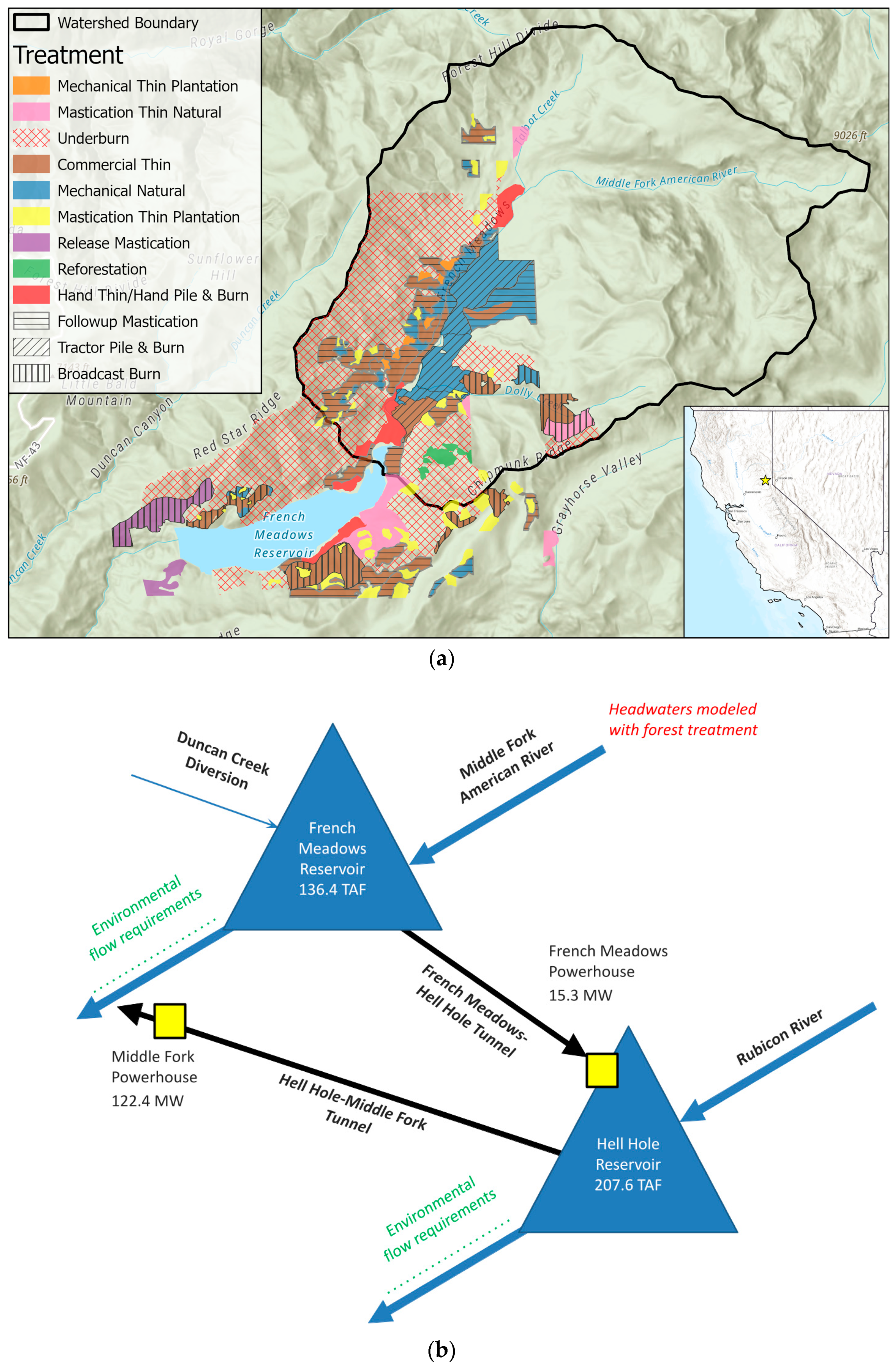
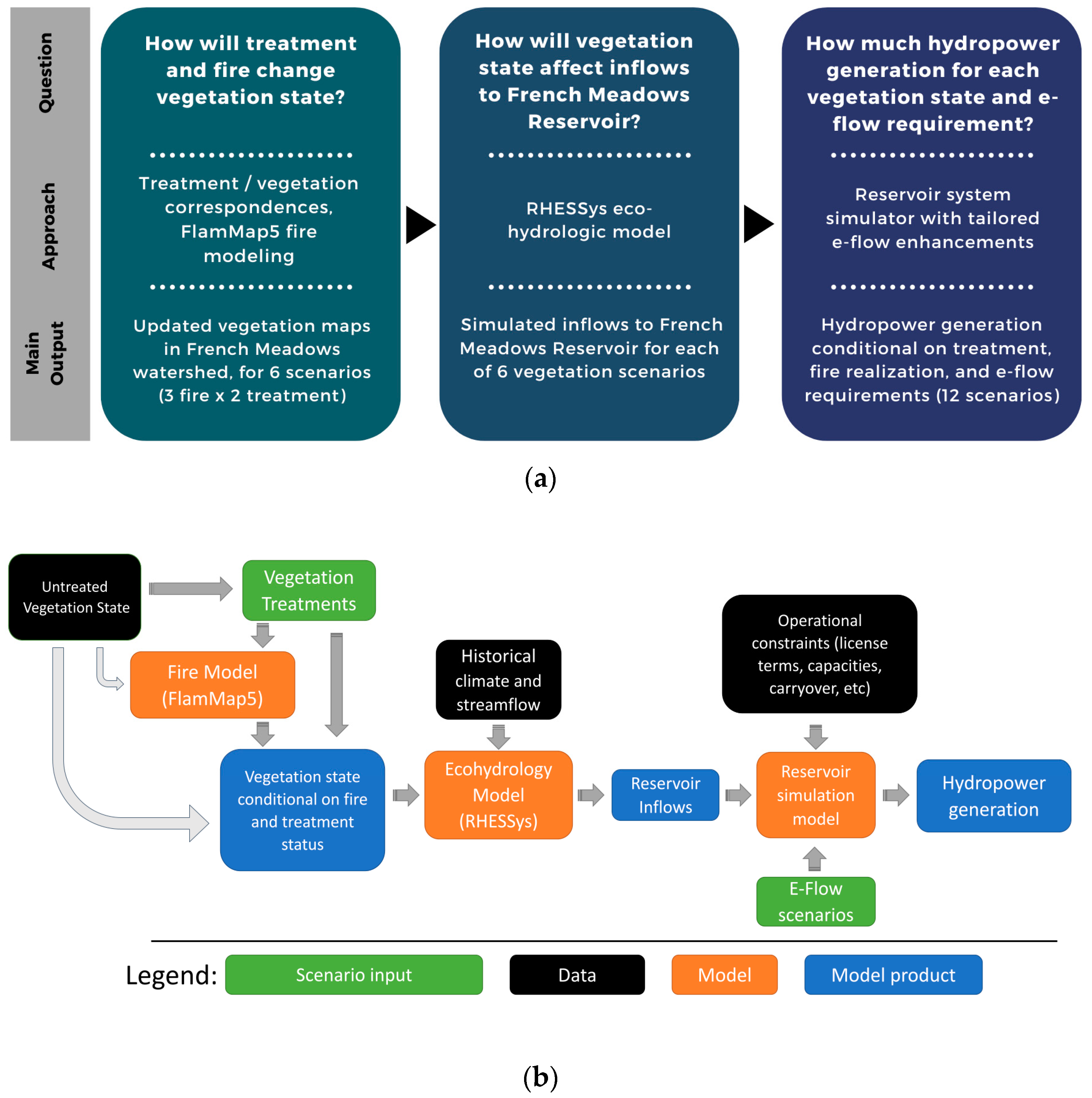
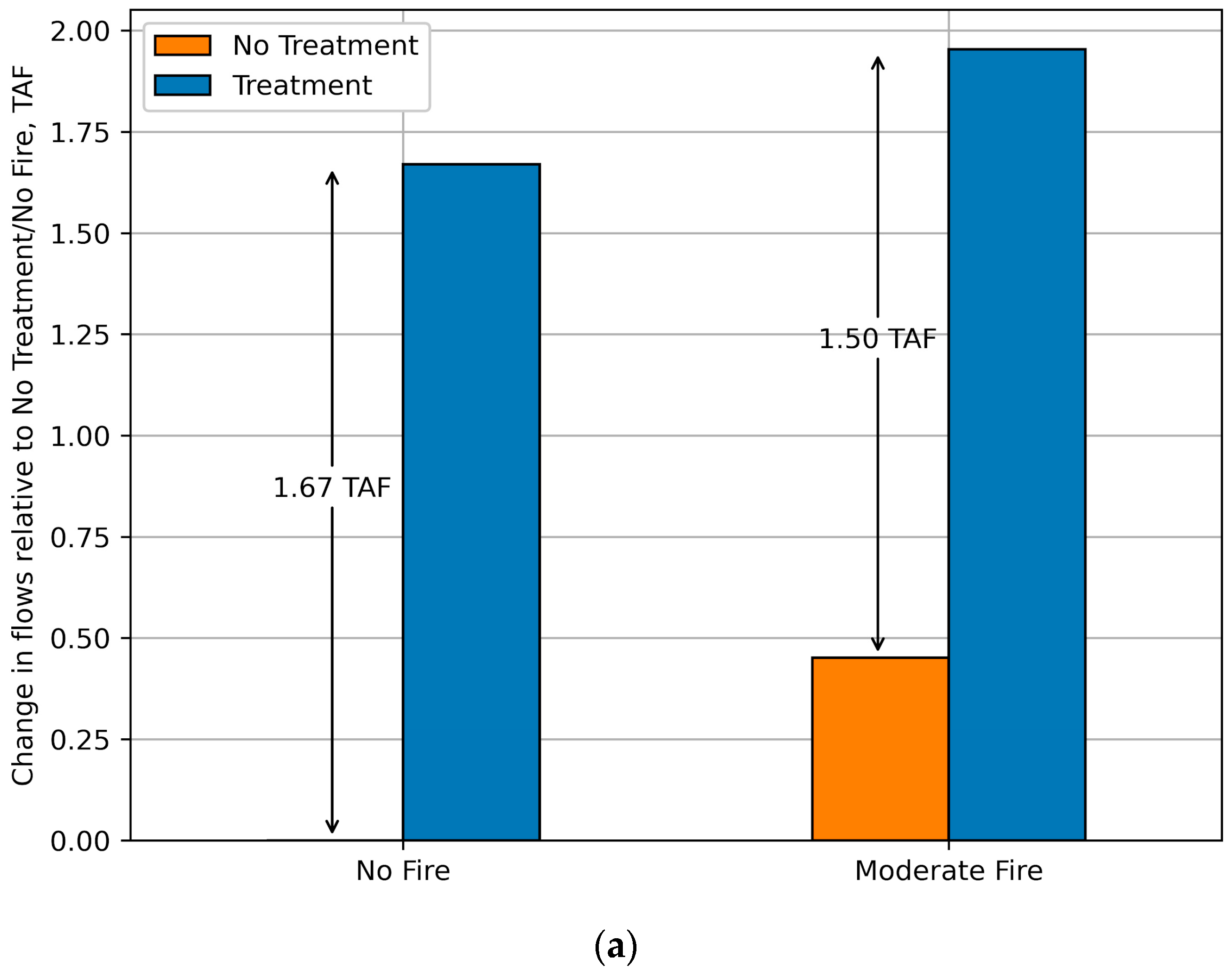
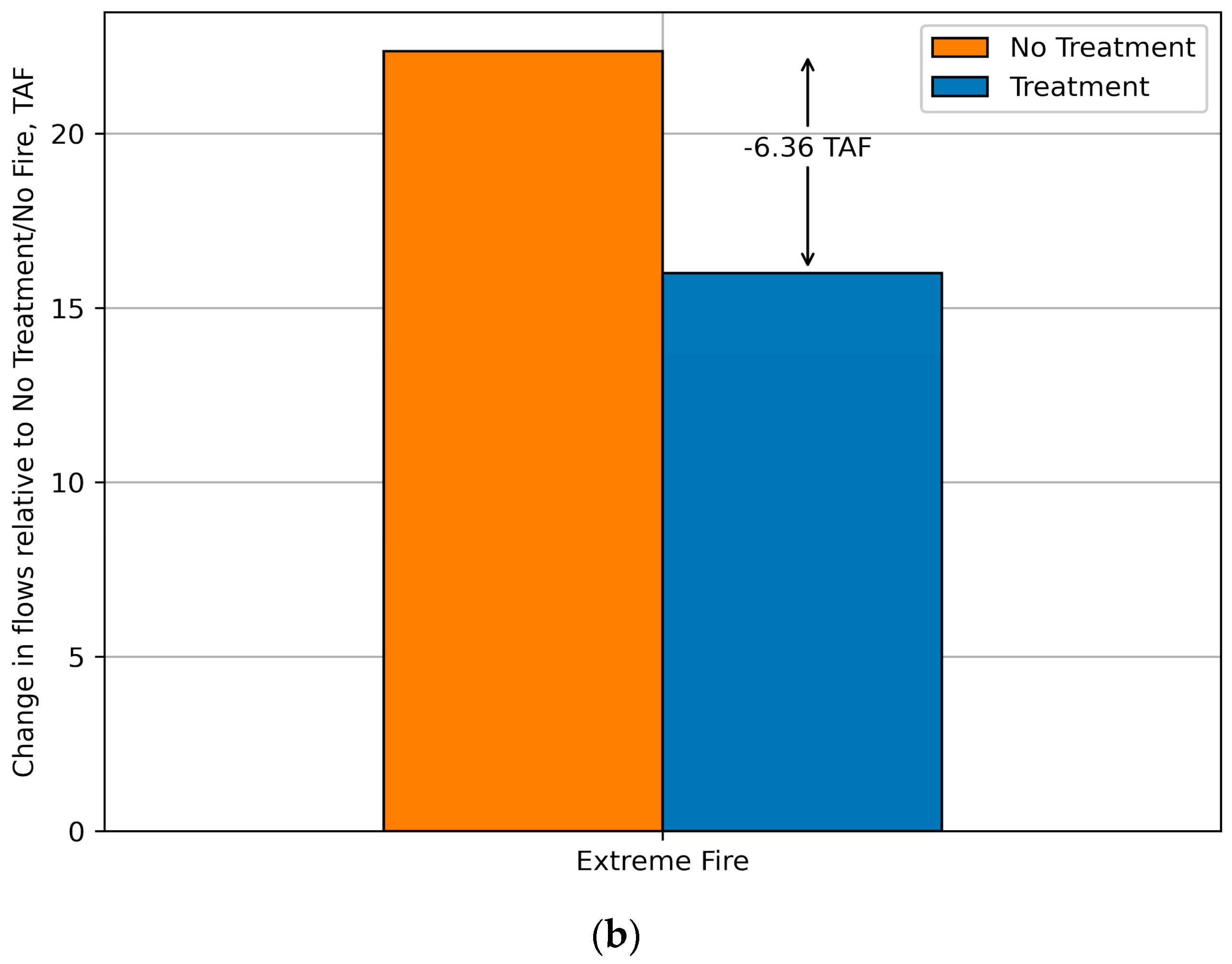
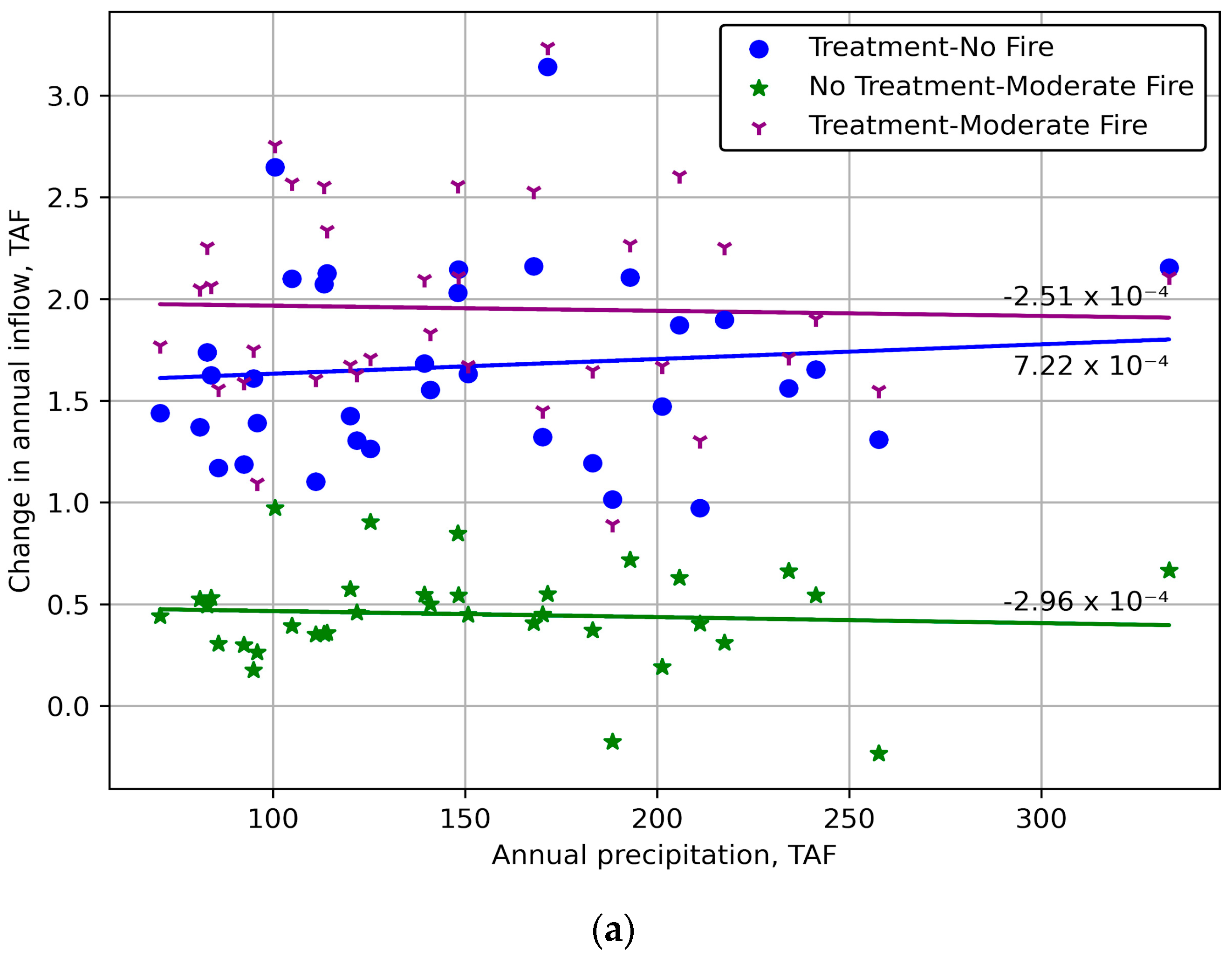
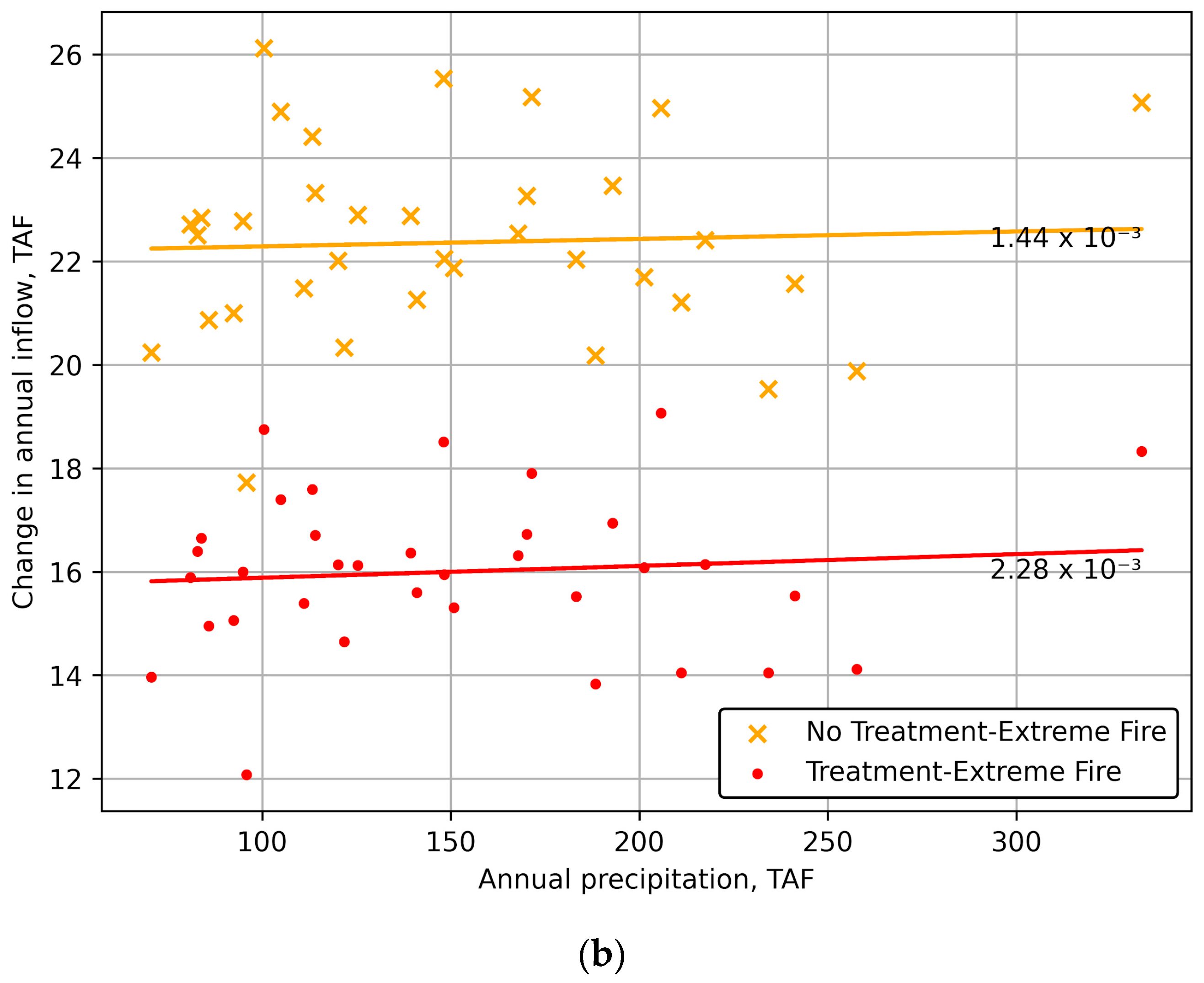
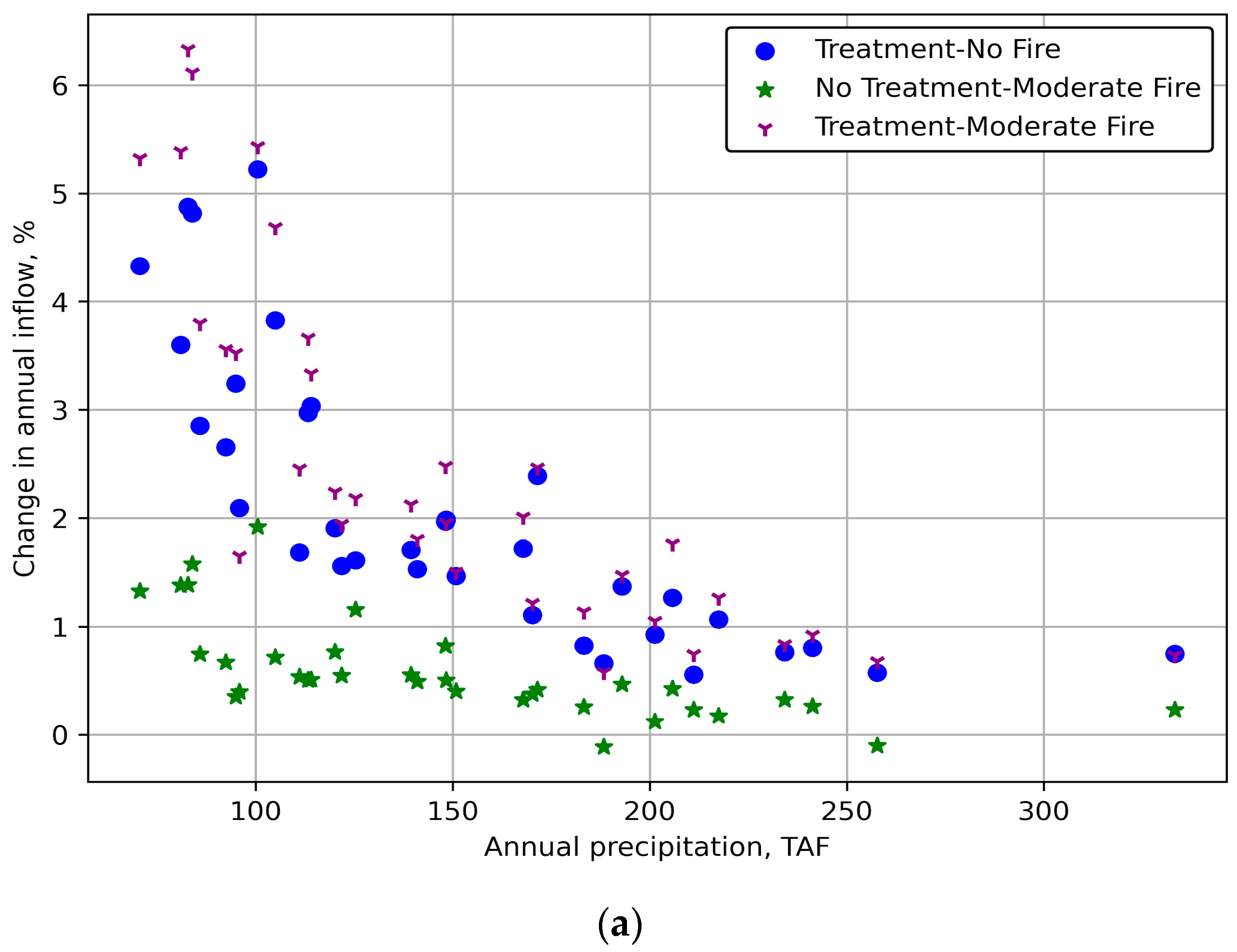
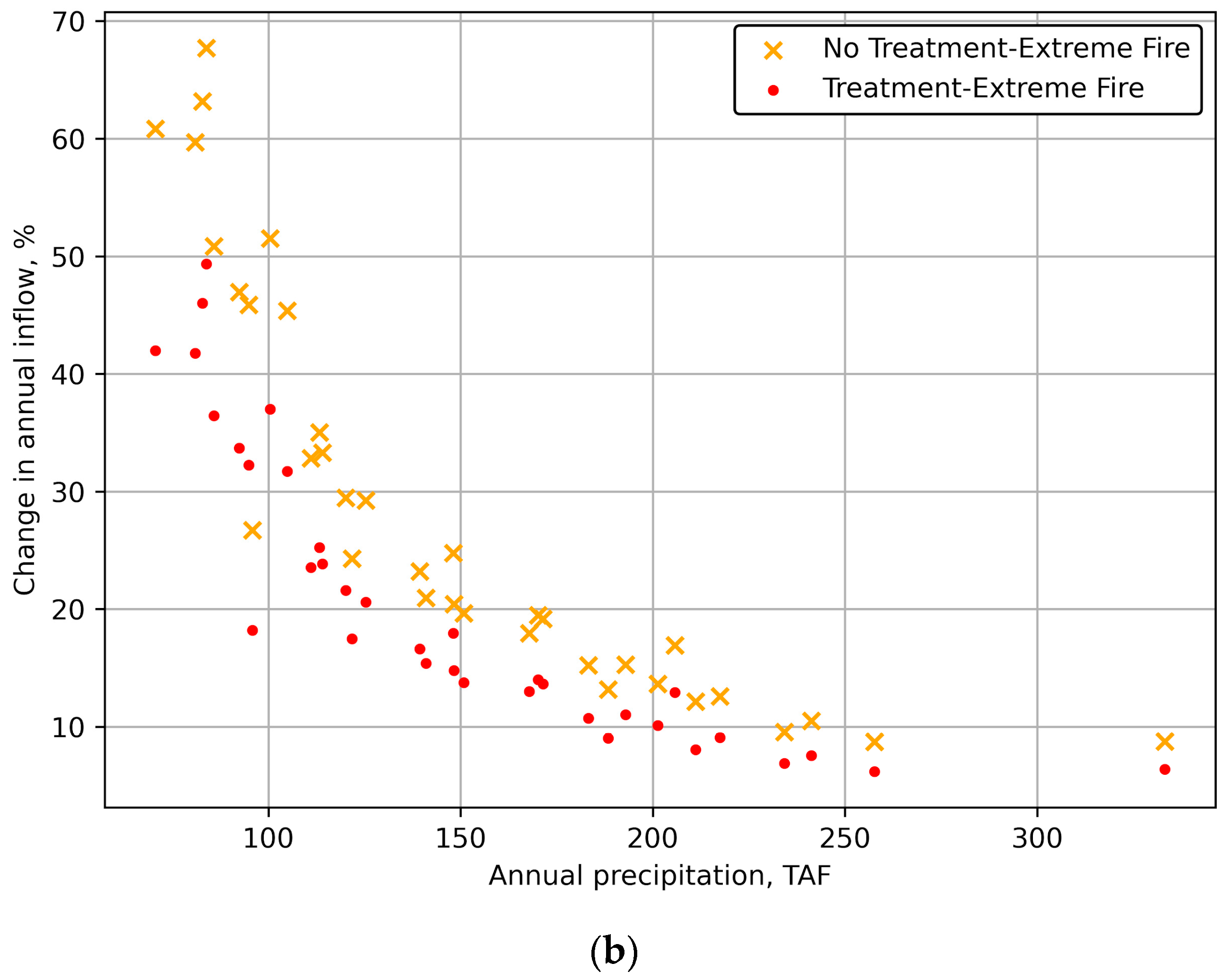
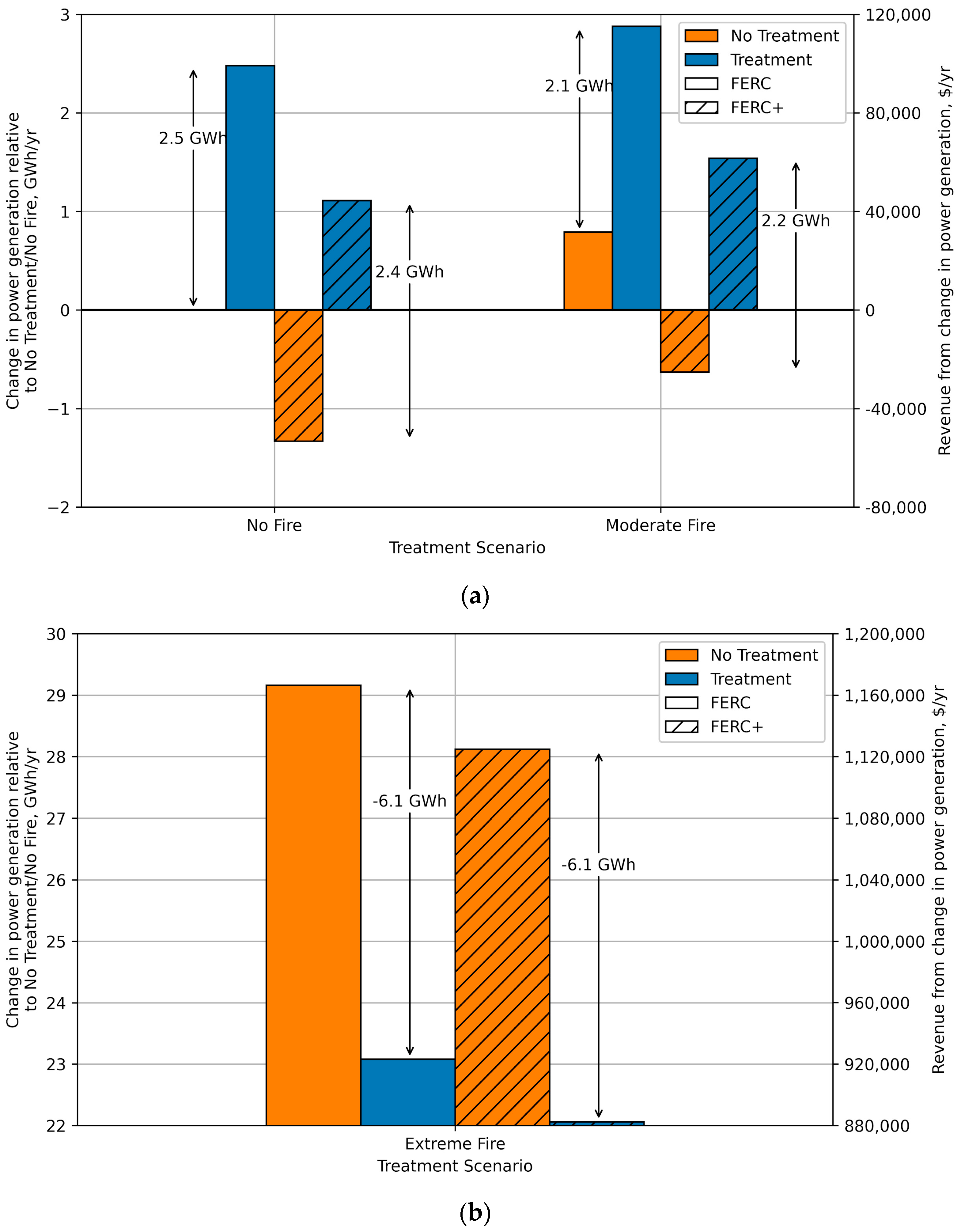

| Untreated | Treated | |||||
|---|---|---|---|---|---|---|
| Fire Scenario | Area Burned (km2) | LAI | Canopy Cover | Area Burned (km2) | LAI | Canopy Cover |
| No Fire | - | 4.94 | 0.47 | - | 4.21 | 0.41 |
| Moderate | 68.8 | 3.83 | 0.40 | 46.7 | 3.49 | 0.37 |
| Extreme | 75.1 | 1.83 | 0.25 | 75.1 | 3.04 | 0.27 |
| Method | Fire Scenario | Unit Generation Potential (MWh/Acre-Foot) | Unit Generation Potential (% of Theoretical Maximum *) | Overestimate Associated with First Principles Approach |
|---|---|---|---|---|
| Integrated modeling | No Fire | 1.49 | 73.0% | 11.7% |
| Moderate Fire | 1.39 | 68.4% | 19.3% | |
| Extreme Fire | 0.956 | 47.0% | 73.6% | |
| First principles approach | N/A | 1.66 | 81.6% | N/A |
Disclaimer/Publisher’s Note: The statements, opinions and data contained in all publications are solely those of the individual author(s) and contributor(s) and not of MDPI and/or the editor(s). MDPI and/or the editor(s) disclaim responsibility for any injury to people or property resulting from any ideas, methods, instructions or products referred to in the content. |
© 2023 by the authors. Licensee MDPI, Basel, Switzerland. This article is an open access article distributed under the terms and conditions of the Creative Commons Attribution (CC BY) license (https://creativecommons.org/licenses/by/4.0/).
Share and Cite
Bryant, B.P.; Maurer, T.; Saksa, P.C.; Herman, J.D.; Wilson, K.N.; Smith, E. Exploring Interacting Effects of Forest Restoration on Wildfire Risk, Hydropower, and Environmental Flows. Sustainability 2023, 15, 11549. https://doi.org/10.3390/su151511549
Bryant BP, Maurer T, Saksa PC, Herman JD, Wilson KN, Smith E. Exploring Interacting Effects of Forest Restoration on Wildfire Risk, Hydropower, and Environmental Flows. Sustainability. 2023; 15(15):11549. https://doi.org/10.3390/su151511549
Chicago/Turabian StyleBryant, Benjamin P., Tessa Maurer, Philip C. Saksa, Jonathan D. Herman, Kristen N. Wilson, and Edward Smith. 2023. "Exploring Interacting Effects of Forest Restoration on Wildfire Risk, Hydropower, and Environmental Flows" Sustainability 15, no. 15: 11549. https://doi.org/10.3390/su151511549
APA StyleBryant, B. P., Maurer, T., Saksa, P. C., Herman, J. D., Wilson, K. N., & Smith, E. (2023). Exploring Interacting Effects of Forest Restoration on Wildfire Risk, Hydropower, and Environmental Flows. Sustainability, 15(15), 11549. https://doi.org/10.3390/su151511549






